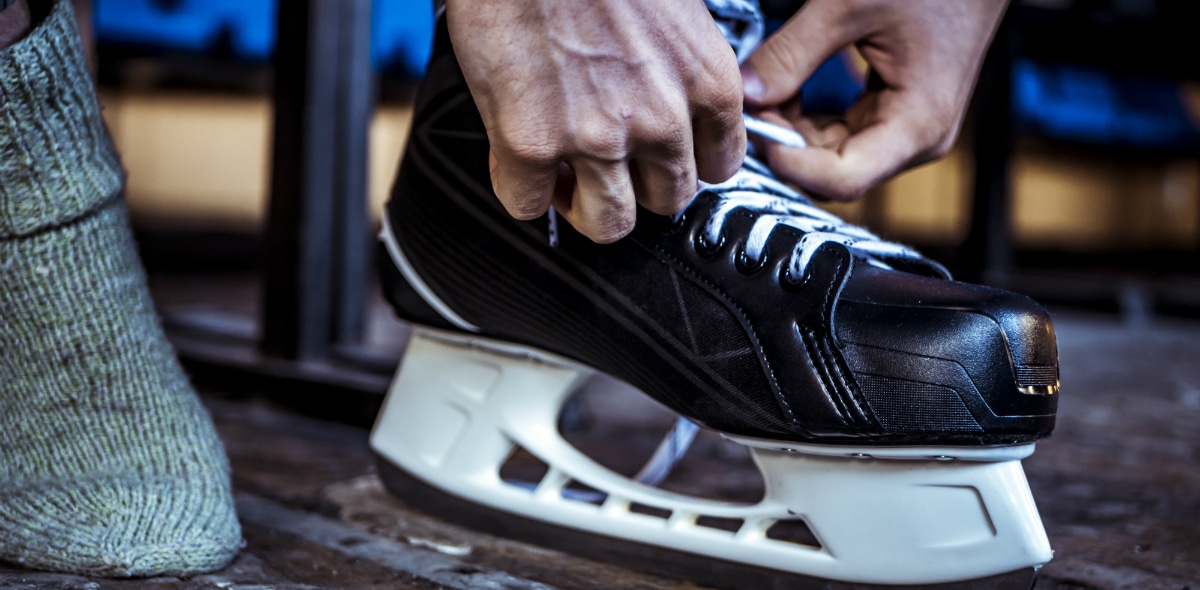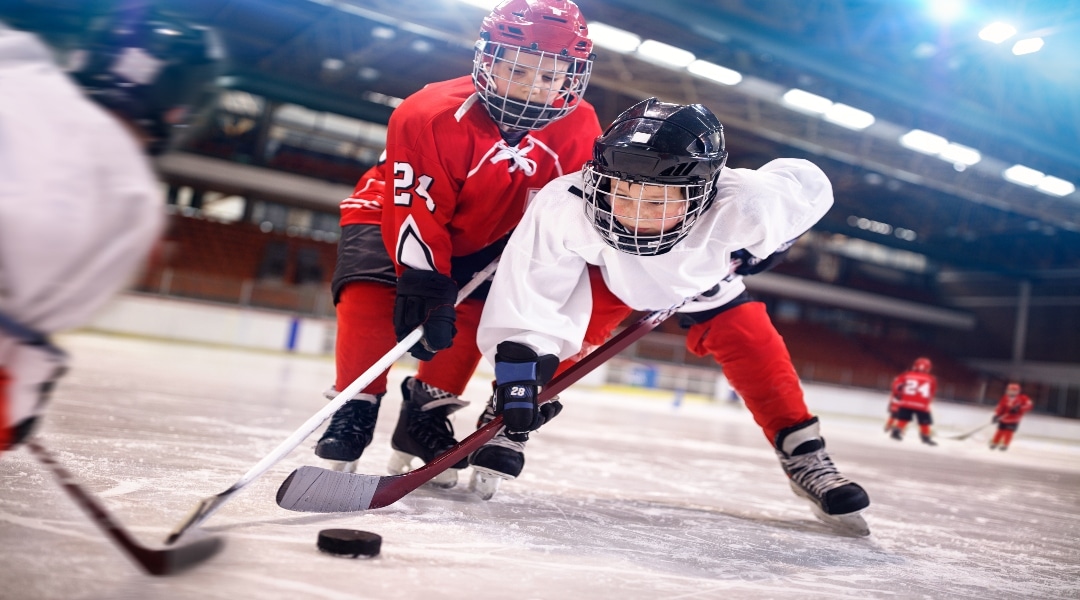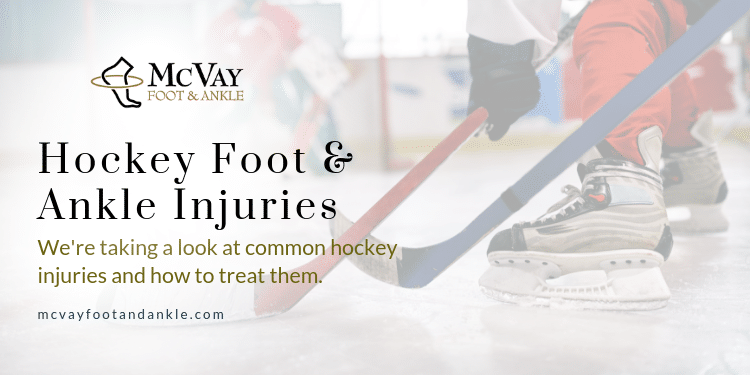A Look at Hockey Foot & Ankle Injuries
For those of us who have been around long enough, it’s hard to believe it’s been 25 years now since the Avalanche first moved to Denver and won their first Stanley Cup. But the evidence is everywhere, from youth and men’s leagues around the state to the first “generation” of post-Avalanche Coloradans starting their NHL careers.
Yes, we have a passionate hockey culture here in Colorado. Of course, with all the hockey being played in the state, there are bound to be plenty of hockey injuries as well, particularly to the feet and ankles. And that’s what we’re here to help with!
Let’s take a closer look at some of the most common foot and ankle injuries associated with ice hockey—plus how to prevent them, and what to do about them if they occur anyway.
Ankle Sprains
Hockey players do sprain their ankles, but usually not in the same way that athletes in most other sports do.
A typical ice skate or roller blade is quite stiff and provides a fair amount of support and stability for the ankle. Plus, there’s not much running and jumping going on. So your standard inversion sprain (common in soccer, basketball, football, etc.) doesn’t happen very often.
Instead, hockey players are more susceptible to what’s called a high ankle sprain to the tendons that attach the lower leg bones (tibia and fibula) to the ankle. Typically this happens when the skate blade catches a rut and the ankle rolls inside to outside (eversion).
You might suspect a high ankle sprain if you feel pain located slightly above your ankle, between the shinbone (tibia) and thighbone (fibula). Pain is often worse when you flex your foot upward, such as when going up or down stairs.
Unfortunately, high ankle sprains often take a while to heal—usually at least 6 weeks, and sometimes much longer. The good news is that they rarely require surgery, and usually respond very well to conservative treatments like rest and physical therapy. It’s important you start treatment early to avoid damaging the ligaments further.
Although there’s no way to fully protect yourself from this type of injury, it helps to wear good skates, avoid playing on poor quality ice surfaces, and consider taping your ankle or wearing a brace—especially if you have a history of ankle injuries.
Lace Bite
Lace bite is marked by pain that can stretch from the front of your lower leg and ankle to your toes, across the top of your foot. It’s usually the result of inflammation and aggravation of the extensor hallucis longus tendon.
That’s a mouthful, but basically it’s a tendon that connects your tibia to the big toe and is important for dorsiflexion, meaning pulling the front of your foot up toward your leg. The other thing you need to know is that when lace bite is severe, taking strides (or even just putting your skate on your foot in the first place) can be excruciating.
Lace bite is also sometimes called skate bite or tongue bite, and the names for the condition should give you a clue here. Most of the time, the problem is that the tongue of the skate is pressing too tightly against the tendon, which can be deeply aggravating as you try to skate around a rink.
Often the problem is that you’re tying your laces too tightly—especially near the top of the skate. However, the tongue itself might be the issue. It might be too stiff and rigid on skates that are brand new and not yet broken in; on the other hand, it may be worn down and no longer padded enough on old, used skates.
Fortunately, lace bite can usually be treated by allowing your feet the time and space needed to rest and recover. In addition to replacing poorly fitting skates, you may need to cut back on your skating/practicing schedule and give your feet more rest on your off days. Icing and over-the-counter painkillers can help when symptoms are flaring up.
Once the pain recedes, make sure you’re practicing good preventative care and not lacing your skates too tightly. It’s also highly recommended that you break in new skates carefully before playing with them at full speed.

Haglund’s Deformity
Haglund’s deformity is an enlarged, bony bump that can develop along the back of the heel, near the base of the Achilles tendon. Basically, constant pressure and irritation leads to inflammation of the soft tissues, which over time can trigger a bony enlargement similar to a heel spur.
This condition is often called “pump bump” because it’s frequently associated with young women who wear pump shoes. But it’s not really about pumps per se—it’s from wearing any overly tight foot gear with a firm, hard back. As you can imagine, ice skates absolutely qualify here.
Wearing skates that are the right size—not too big, not too small—is critical if you want to either prevent Haglund’s deformity or minimize any symptoms from one that already exists. You may also consider heel lifts or pads to relieve pressure on the bump.
When you’re not on the ice, stick to backless or soft-backed footwear that doesn’t irritate the back of the heel.
A Haglund’s deformity is permanent unless surgically removed, so that may become a consideration if conservative treatments no longer allow you to play without pain.
Bruises and Fractures
If you’ve ever been hit by a 6 oz. slab of vulcanized rubber traveling at more than 80 miles per hour, you probably know that it hurts. A lot.
Despite the stiff protection affordable by skates and padding, the impact force of an inconveniently placed puck or stick can still leave a nasty bruise—or in some cases even crack bone.
Catastrophic fractures in hockey are of course very rare and more likely the result of freak incidents. But mild to moderate fractures of the toes, the navicular bone (along the inside of the arch) and the fifth metatarsal (outside of the midfoot) are not that uncommon.
Best rule of thumb is simply that if it hurts, take it seriously. Any possible fracture (including toe fractures) should be evaluated by a foot specialist as soon as possible. In the meantime, keep your feet up and avoid putting unnecessary pressure on the area to reduce the risk of worsening the injury.

Additional Advice on Dealing with Hockey Injuries
If you’ve been following along so far, it should be pretty clear that skates and equipment make a huge difference.
Hockey isn’t like soccer or basketball, where you pretty much just need shoes and a ball. Getting skates that fit correctly, breaking them in, and protecting your body with high quality padding and gear will significantly reduce your injury risk.
But let’s say you get hurt anyway. Under ordinary circumstances, break a foot and you’re looking at a month or two of immobilization. Lace bite? That can drag on for what seems like forever even if you’re diligent about conservative care. Where do you turn?
In our humble opinion, you’re going to want to see a medical team that specializes in sports injury treatment specifically for the feet and ankles, and works with athletes every day—including athletes who play your chosen sport.
Our team of experts can properly identify the root causes and inflamed tissues involved with your injury, and help you develop a customized treatment plan to remedy it.
Want to get back on the ice, at full speed, as quickly as possible? Stop by and see us in Colorado Springs in our new office at 8580 Scarborough Drive—we’re always happy to meet new patients! You can fill out a contact form online, or call our office directly at (719) 266-5000.
© McVay Foot & Ankle. All Rights Reserved
Web Design by CP Solutions
Marketed by VMD Services
Privacy Policy | Terms & Conditions

